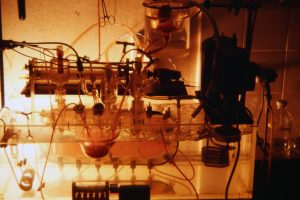
Apparatur zur In vitro Perfusion Perfusion von Ovarien
- Die in vitro Untersuchungen zur Ovarphysiologie im Besonderen zur Ovulation bei Mensch und Rind nutzten die Follikeldruckmessung, Druckmessung im Gewebe und im arteriellen Schenkel.
- Mit Ekkehard Stähler wurde eine Apparatur entwickelt, die es erlaubte ein Ovar (Mensch oder Rind) für einige Stunden mit Sauerstoff und Nährstoffen zu entwickeln.So waren dort gezielt Stoffwechseluntersuchungen, aber auch physiologische Untersuchungen durchzuführen und die Reaktion auf unterschiedliche Substanzen möglich. Die Deutschen Forschungsgemeinschaft unterstützte diese Untersuchungen.
- Es konnten im in vitro perfundierten menschlichen Ovar erstmalig im wissenschaftlichen Experipent Ovulationen induziert werden (ovulation Arch Gynec 1974) (siehe Bilder auf der ersten Seite, PDF).
- Da es während der Ovulation zu keiner intrafollikulären Druckerhöhung kommt, geht man davon aus, dass die Erhöhung der intrfollikulären Prostaglandinkonzentration die tunica albuginea andaut und es dann nur noch zum Ausfließen der Follikelflüssigkeit kommt. Entgegen bisheriger Annahme

Ovulation am Ovar des Menschen. Follikeldruckmessung zeigt Ausfließen der Follikelflüssigkeit bei Ovulation ohne Druckerhöhung.
- Im Gegensatz zur allgemeinen Vermutung kommt es bei der Ovulation nicht zu einer intrafollikulären Druckerhöhung. (Der der Follikel platzt bei der Ovulation nicht. Bild, PDF)
- Es lassen sich im Ovargewebe Druckschwankungen nachweisen, die durch FSH/HCG stimulierbar und durch Prostaglandinsynthesehemmer (Indomethacin) blockierbar sind (Ovar Druck Gewebe Arch Gynäk 1977 , Ovar Druck Indometacin Prostaglandins 1982)(Bild, PDF)
- Dazu weitere Publikationen: Ovar CL Prolactin Arch Gyn 1982; Ovar LH Arch Gyn 1972 002; Ovar Druck Gewebe Arch Gyn 1977